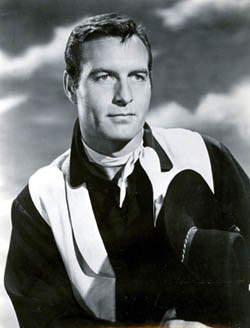 GEORGE MONTGOMERY GEORGE MONTGOMERY
Ratings: Zero to 4 Stars.
Before becoming a top-billed western star, George Montgomery was featured and co-starred in several westerns, including Republic’s “Lone Ranger” serial in ‘38, bits in several Gene Autry and Roy Rogers pictures, “The Cisco Kid and the Lady” (‘39) with Cesar Romero and “Cowboy and the Blonde” (‘41) at 20th Century Fox—a light, breezy romantic comedy.
 LAST OF THE DUANES (‘41 20TH Century Fox) George Montgomery’s first starring western (discounting the co-medic taming-of-the-shrew “Cowboy and the Blonde”, ‘41 Fox) is an early exhibit of all the right western “stuff” George was later to utilize so well in westerns of the ‘50s. He’s a little uneasy in certain scenes, but perfect in others. “Duanes” is a loose remake of a Zane Grey story Fox filmed twice before in silent versions with William Farnum and Tom Mix. In this version, the early father-son relationship is skimmed over with Buck Duane’s (George) sheriff father being killed in the first scenes. To revenge his father’s death at the hands of Harry Woods, George hits the outlaw trail with old timer Francis Ford (in a shining example of how good an actor he could be, given the part). Seems George’s childhood girlfriend (a wasted Lynne Roberts) has been kidnapped by Don Costello and Joe Sawyer’s gang after they killed her father in a ranch raid. George (and pal George E. Stone) rescue her—and that’s the last we see of Lynne Roberts (although she received 2nd billing). Saloon owner Eve Arden (acting just like OUR MISS BROOKS even then) falls for George even though she’s been siding with the mystery leader of the gang (won’t reveal that plot point here). Noting George’s good points and believing he has the stuff to make a Texas Ranger, Ranger Major William Farnum offers George a pardon to work undercover and bring the gang—and its mystery leader—to justice. It’s a lot of plot—too much—for a one hour B-western. All in all, George’s first starrer just misses the top ranks due to its too-fast-on-the-crucial-plot-points pace. LAST OF THE DUANES (‘41 20TH Century Fox) George Montgomery’s first starring western (discounting the co-medic taming-of-the-shrew “Cowboy and the Blonde”, ‘41 Fox) is an early exhibit of all the right western “stuff” George was later to utilize so well in westerns of the ‘50s. He’s a little uneasy in certain scenes, but perfect in others. “Duanes” is a loose remake of a Zane Grey story Fox filmed twice before in silent versions with William Farnum and Tom Mix. In this version, the early father-son relationship is skimmed over with Buck Duane’s (George) sheriff father being killed in the first scenes. To revenge his father’s death at the hands of Harry Woods, George hits the outlaw trail with old timer Francis Ford (in a shining example of how good an actor he could be, given the part). Seems George’s childhood girlfriend (a wasted Lynne Roberts) has been kidnapped by Don Costello and Joe Sawyer’s gang after they killed her father in a ranch raid. George (and pal George E. Stone) rescue her—and that’s the last we see of Lynne Roberts (although she received 2nd billing). Saloon owner Eve Arden (acting just like OUR MISS BROOKS even then) falls for George even though she’s been siding with the mystery leader of the gang (won’t reveal that plot point here). Noting George’s good points and believing he has the stuff to make a Texas Ranger, Ranger Major William Farnum offers George a pardon to work undercover and bring the gang—and its mystery leader—to justice. It’s a lot of plot—too much—for a one hour B-western. All in all, George’s first starrer just misses the top ranks due to its too-fast-on-the-crucial-plot-points pace.
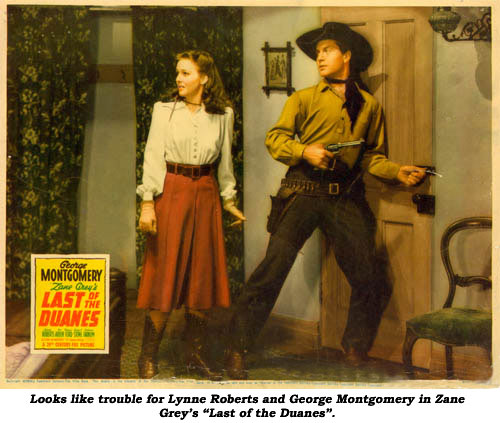
 RIDERS OF THE PURPLE SAGE (‘41 20TH Century Fox) This Zane Grey novel was filmed in ‘31 with George O’Brien. Unfortunately, star Montgomery doesn’t quite have the same charisma O’Brien brought to the previous version. Montgomery comes to Cotton-wood, AZ, seeking revenge on the man who stole his sister and her baby from her husband 15 years earlier. Montgomery sides with rancher Mary Howard against ruthless Robert Barrat who operates a corrupt vigilante group out to grab off all the prime ranchland. Montgomery confronts Barrat’s right hand man, Richard Lane, who confesses it was Barrat who stole George’s sister and gave her daughter to him to raise after the sister died. The plotline and ending is pretty much identical to the O’Brien version, but the involved overall storytelling is actually better handled in this version. RIDERS OF THE PURPLE SAGE (‘41 20TH Century Fox) This Zane Grey novel was filmed in ‘31 with George O’Brien. Unfortunately, star Montgomery doesn’t quite have the same charisma O’Brien brought to the previous version. Montgomery comes to Cotton-wood, AZ, seeking revenge on the man who stole his sister and her baby from her husband 15 years earlier. Montgomery sides with rancher Mary Howard against ruthless Robert Barrat who operates a corrupt vigilante group out to grab off all the prime ranchland. Montgomery confronts Barrat’s right hand man, Richard Lane, who confesses it was Barrat who stole George’s sister and gave her daughter to him to raise after the sister died. The plotline and ending is pretty much identical to the O’Brien version, but the involved overall storytelling is actually better handled in this version.
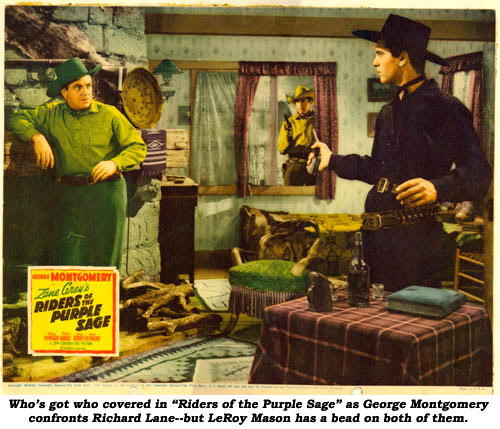
 BELLE STARR’S DAUGHTER (‘47 20TH Century Fox) Marshal Montgomery raids the outlaw laden Cherokee Flats held by Belle Starr (Isabel Jewell—who also played the lady outlaw in “Badman’s Territory” ‘46). Fleeing, nasty Bittercreek (Rod Cameron) kills Belle in an argument. Belle’s daughter, Rose of Cimarron (Ruth Roman), winds up working in a beanery in Montgomery’s town, where they begin to fall in love…until Cameron’s new gang arrives and leads Rose astray, making her believe it was Montgomery who killed her mother. Cameron steals the picture in the larger and far showier role as bandit Bittercreek. Solidly in the “famous outlaws” cycle of the late ‘40s, but historically inaccurate as Belle’s children were Pearl (fathered by outlaw Cole Younger) and Edward. The real Belle was bushwhacked mysteriously. BELLE STARR’S DAUGHTER (‘47 20TH Century Fox) Marshal Montgomery raids the outlaw laden Cherokee Flats held by Belle Starr (Isabel Jewell—who also played the lady outlaw in “Badman’s Territory” ‘46). Fleeing, nasty Bittercreek (Rod Cameron) kills Belle in an argument. Belle’s daughter, Rose of Cimarron (Ruth Roman), winds up working in a beanery in Montgomery’s town, where they begin to fall in love…until Cameron’s new gang arrives and leads Rose astray, making her believe it was Montgomery who killed her mother. Cameron steals the picture in the larger and far showier role as bandit Bittercreek. Solidly in the “famous outlaws” cycle of the late ‘40s, but historically inaccurate as Belle’s children were Pearl (fathered by outlaw Cole Younger) and Edward. The real Belle was bushwhacked mysteriously.
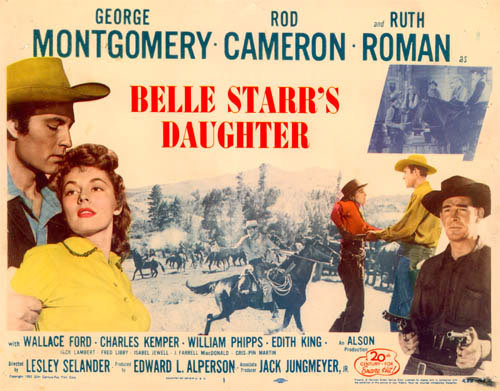
 DAVY CROCKETT, INDIAN SCOUT (‘50 United Artists) No coonskin cap here; Montgomery wears a cowboy hat as he’s really the nephew of the famous scout. Very routine, its budgetary limitations evident in the vast amount of stock footage. DAVY CROCKETT, INDIAN SCOUT (‘50 United Artists) No coonskin cap here; Montgomery wears a cowboy hat as he’s really the nephew of the famous scout. Very routine, its budgetary limitations evident in the vast amount of stock footage.
 DAKOTA LIL (‘50 20th Century Fox) Murderous ban-dit Rod Cameron viciously stran-gles a train guard in the first scene which brings Secret Service agent Montgomery to Mexico to work his way undercover with counterfeiter Dakota Lil (Marie Windsor) and her accomplice, Cameron as Kid Curry of the Hole In the Wall Gang, who is partners with Butch Cassidy (Walter Sande). This film actually contains the line, “What’s a smart girl like you doing in a broken down Cantina like this?” Marie said Marni Nixon dubbed her singing but UCLA records indicate Anita Ellis was hired for the job. Nixon, a popular “dubber of stars” singing voices, dubbed Natalie Wood in “West Side Story” among others, while jazz singer Ellis dubbed Rita Hayworth in “Gilda” and others. Look for one time star Jack Perrin in a small role. DAKOTA LIL (‘50 20th Century Fox) Murderous ban-dit Rod Cameron viciously stran-gles a train guard in the first scene which brings Secret Service agent Montgomery to Mexico to work his way undercover with counterfeiter Dakota Lil (Marie Windsor) and her accomplice, Cameron as Kid Curry of the Hole In the Wall Gang, who is partners with Butch Cassidy (Walter Sande). This film actually contains the line, “What’s a smart girl like you doing in a broken down Cantina like this?” Marie said Marni Nixon dubbed her singing but UCLA records indicate Anita Ellis was hired for the job. Nixon, a popular “dubber of stars” singing voices, dubbed Natalie Wood in “West Side Story” among others, while jazz singer Ellis dubbed Rita Hayworth in “Gilda” and others. Look for one time star Jack Perrin in a small role.
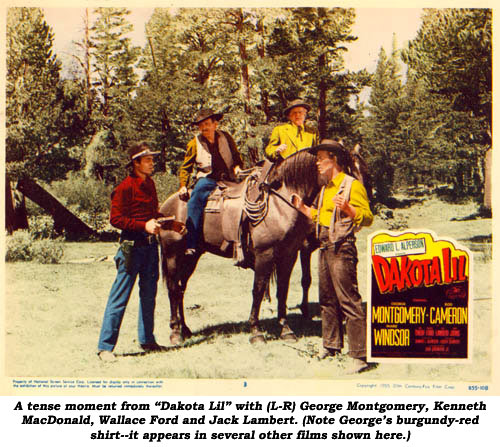
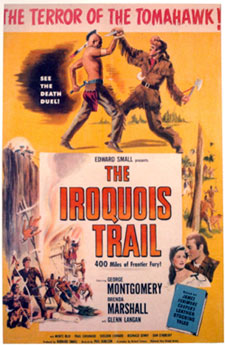  IROQUOIS TRAIL (‘50 United Artists) Colonial cowboy Montgomery as James Fenimore Cooper’s legendary Hawkeye with Monte Blue as his friend the Sagamore, find Hawkeye’s kid brother ambushed and murdered by treacherous French spies who have stolen vital British war dispatches. The pair aid the British in a French attack on Fort Williams, rescue the commandant of the fort’s daughter and uncover a traitor. Superficial script with some good action toward the end. Producer Edward Small seemed to favor period “westerns” and historical costume dramas. IROQUOIS TRAIL (‘50 United Artists) Colonial cowboy Montgomery as James Fenimore Cooper’s legendary Hawkeye with Monte Blue as his friend the Sagamore, find Hawkeye’s kid brother ambushed and murdered by treacherous French spies who have stolen vital British war dispatches. The pair aid the British in a French attack on Fort Williams, rescue the commandant of the fort’s daughter and uncover a traitor. Superficial script with some good action toward the end. Producer Edward Small seemed to favor period “westerns” and historical costume dramas.
 TEXAS RANGERS (‘51 Columbia) One of George’s best in Cinecolor from the “outlaw cycle” of the late ‘40s early ‘50s. Like the others, it plays fast and loose with the facts. Two former outlaws, Montgomery and Noah Beery Jr., join the Texas Rangers then infiltrate a gang of long-riders headed by Sam Bass (William Bishop). Richard Schayer’s screenplay was reworked as “Arizona Raiders” with Audie Murphy in ‘65. TEXAS RANGERS (‘51 Columbia) One of George’s best in Cinecolor from the “outlaw cycle” of the late ‘40s early ‘50s. Like the others, it plays fast and loose with the facts. Two former outlaws, Montgomery and Noah Beery Jr., join the Texas Rangers then infiltrate a gang of long-riders headed by Sam Bass (William Bishop). Richard Schayer’s screenplay was reworked as “Arizona Raiders” with Audie Murphy in ‘65.
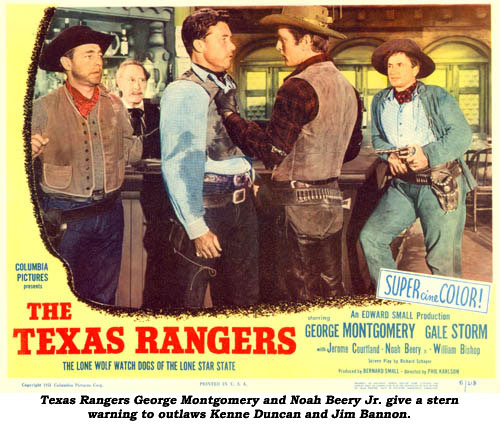
 INDIAN UPRISING (‘51 Columbia) Cavalry Captain Montgomery fights to keep peace in Arizona between famed Indian Chief Geronimo and local white settlers. The Indian reservation contains rich gold deposits the bad guys scheme to get. Between their misdeeds and Washington, D.C., bungling, you can be sure Geronimo heeds the title of this Cinecolor adventure. But overall, in the wake of the success of “Broken Arrow” six months earlier, this film reflects the more positive attitude being afforded Indians in westerns. Story was rewritten for Audie Murphy’s “Apache Rifles” in ‘64. INDIAN UPRISING (‘51 Columbia) Cavalry Captain Montgomery fights to keep peace in Arizona between famed Indian Chief Geronimo and local white settlers. The Indian reservation contains rich gold deposits the bad guys scheme to get. Between their misdeeds and Washington, D.C., bungling, you can be sure Geronimo heeds the title of this Cinecolor adventure. But overall, in the wake of the success of “Broken Arrow” six months earlier, this film reflects the more positive attitude being afforded Indians in westerns. Story was rewritten for Audie Murphy’s “Apache Rifles” in ‘64.
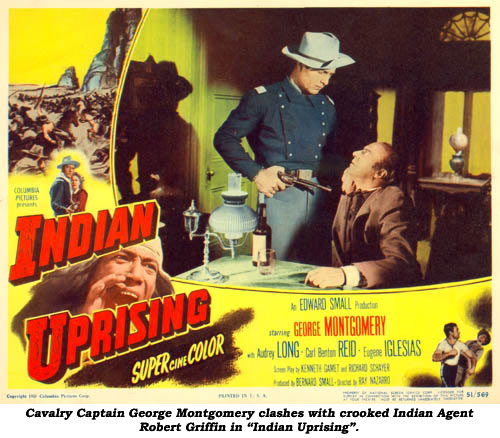
 CRIPPLE CREEK (‘52 Columbia) Three Secret Service Agents (George, Jerome Courtland, Richard Egan) infiltrate slick William Bishop’s outlaw gang to land a death blow on his smuggling operation which involves lead plated gold bricks smelted in a secret underground mine. Richard Schayer’s script is tense and exacting with a few twists. In Cinecolor. CRIPPLE CREEK (‘52 Columbia) Three Secret Service Agents (George, Jerome Courtland, Richard Egan) infiltrate slick William Bishop’s outlaw gang to land a death blow on his smuggling operation which involves lead plated gold bricks smelted in a secret underground mine. Richard Schayer’s script is tense and exacting with a few twists. In Cinecolor.
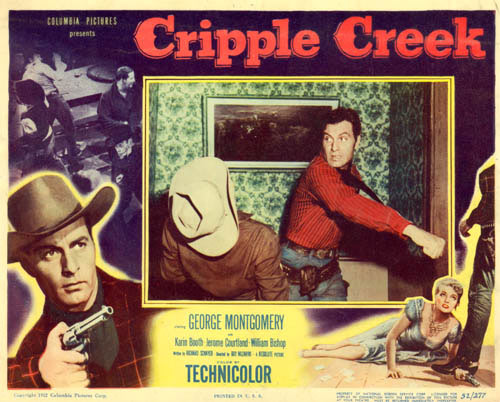
 PATHFINDER (‘52 Columbia) Not much from James Fenimore Cooper’s novel can be recognized in this Montgomery colonial western. Pathfinder (Montgomery) and Chingachgook (Jay Silverheels) are sent on a dangerous mission to find the secret defense of the key French fortress of St. Vincente. As Pathfinder doesn’t speak French, he’s forced to take along spy Helena Carter who does parlez the vous. Typical Sam Katzman Columbia stuff, in color. PATHFINDER (‘52 Columbia) Not much from James Fenimore Cooper’s novel can be recognized in this Montgomery colonial western. Pathfinder (Montgomery) and Chingachgook (Jay Silverheels) are sent on a dangerous mission to find the secret defense of the key French fortress of St. Vincente. As Pathfinder doesn’t speak French, he’s forced to take along spy Helena Carter who does parlez the vous. Typical Sam Katzman Columbia stuff, in color.
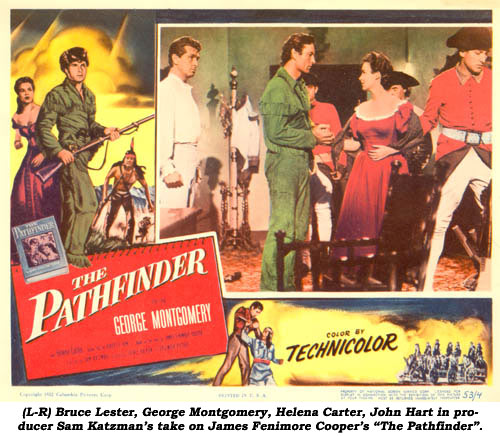
 JACK McCALL DESPERADO (‘53 Columbia) Totally fictional account of why and how Jack McCall (George) killed Wild Bill Hickok (Douglas Kennedy) in Deadwood, SD. Toward the end of the Civil War, Union cavalryman Montgomery is framed by Southern soldiers uniformed as Yankees then sentenced to death for treason. He escapes, hoping to track down those who framed him. Meanwhile, George’s cousin (James Seay) and Hickok murder George’s parents and take over their plantation. When the war ends George seeks revenge, with everyone winding up in the Dakotas where Hickok is trying to cheat the Indians out of their gold-studded land. As far as I know, Hickok was never a Union sergeant, only a scout. He didn’t come to Deadwood until 10 years after the Civil War was over where he was shot in the back by lowlife, murderous McCall, not in a fair fight as shown here. The real McCall was hanged for his crime. This movie must be about two other individuals coincidentally with the same historic names. JACK McCALL DESPERADO (‘53 Columbia) Totally fictional account of why and how Jack McCall (George) killed Wild Bill Hickok (Douglas Kennedy) in Deadwood, SD. Toward the end of the Civil War, Union cavalryman Montgomery is framed by Southern soldiers uniformed as Yankees then sentenced to death for treason. He escapes, hoping to track down those who framed him. Meanwhile, George’s cousin (James Seay) and Hickok murder George’s parents and take over their plantation. When the war ends George seeks revenge, with everyone winding up in the Dakotas where Hickok is trying to cheat the Indians out of their gold-studded land. As far as I know, Hickok was never a Union sergeant, only a scout. He didn’t come to Deadwood until 10 years after the Civil War was over where he was shot in the back by lowlife, murderous McCall, not in a fair fight as shown here. The real McCall was hanged for his crime. This movie must be about two other individuals coincidentally with the same historic names.
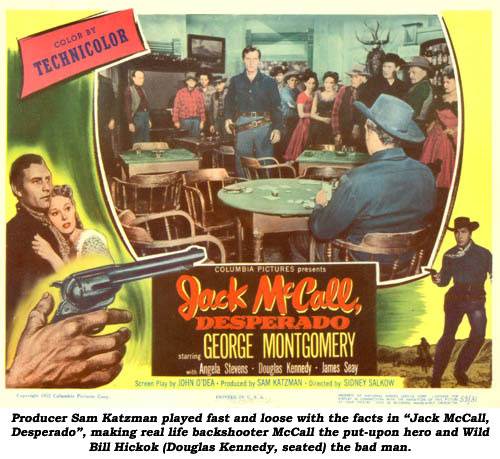
 FORT TI (‘53 Columbia) Strictly a Sam Katzman B-movie approach to history, but being one of the earliest 3-D movies with flaming arrows, cannonballs and all sorts of gimmicky shots from director William Castle exploding from the screen to a ducking audience, “Fort Ti” cleaned up at the boxoffice. During the pre-Revolutionary French and Indian Wars, a French spy blackmails scout Montgomery’s brother-in-law (James Seay) into feeding him information. Montgomery turns the table, feeds the French false information and effects the rescue from Indians of English lass Joan Vohs, at first suspected of being a French spy. The expected big final battle at Fort Ticonderoga is a disappointment. FORT TI (‘53 Columbia) Strictly a Sam Katzman B-movie approach to history, but being one of the earliest 3-D movies with flaming arrows, cannonballs and all sorts of gimmicky shots from director William Castle exploding from the screen to a ducking audience, “Fort Ti” cleaned up at the boxoffice. During the pre-Revolutionary French and Indian Wars, a French spy blackmails scout Montgomery’s brother-in-law (James Seay) into feeding him information. Montgomery turns the table, feeds the French false information and effects the rescue from Indians of English lass Joan Vohs, at first suspected of being a French spy. The expected big final battle at Fort Ticonderoga is a disappointment.
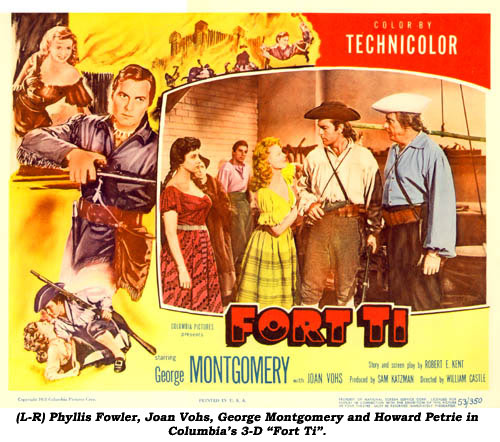
 GUN BELT (‘53 U. A.) Better than average Montgomery western (in color) directed by Ray Nazarro with performances all around that reach beyond the material—except maybe Tab Hunter, who was a current teen favorite but is out of his element here. John Dehner, as Tab’s outlaw Dad and Montgomery’s brother, dominates the initial part of the film but is killed early on. Set in Tomb-stone, there’s not a whit of his-torical accuracy to this story in which Dehner tries to lure his brother-gone-straight, Montgomery, back into a “big job.” Montgomery has been raising Dehner’s son (Hunter) on the right side of the law while his father rode the outlaw trail. When Montgomery kills Dehner in a fight, Hunter rebels, joining Dehner’s gang and vowing to gun Uncle George. Plenty of suspense, action and double-up-crosses, all nicely done. Remade as “Five Guns to Tombstone” in ‘61. GUN BELT (‘53 U. A.) Better than average Montgomery western (in color) directed by Ray Nazarro with performances all around that reach beyond the material—except maybe Tab Hunter, who was a current teen favorite but is out of his element here. John Dehner, as Tab’s outlaw Dad and Montgomery’s brother, dominates the initial part of the film but is killed early on. Set in Tomb-stone, there’s not a whit of his-torical accuracy to this story in which Dehner tries to lure his brother-gone-straight, Montgomery, back into a “big job.” Montgomery has been raising Dehner’s son (Hunter) on the right side of the law while his father rode the outlaw trail. When Montgomery kills Dehner in a fight, Hunter rebels, joining Dehner’s gang and vowing to gun Uncle George. Plenty of suspense, action and double-up-crosses, all nicely done. Remade as “Five Guns to Tombstone” in ‘61.
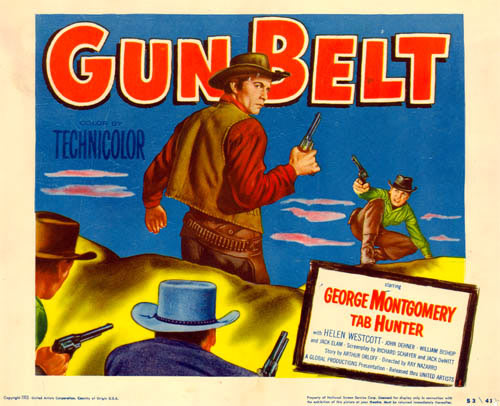
 BATTLE OF ROGUE RIVER (‘54 Columbia) Montgomery is back in uniform as a stern but honest Cavalry officer faced with bringing peace to the Rogue River Valley and paving the way for statehood while Richard Denning and others keep the Indians in a state of warpaint so all the rich Oregon mineral lands can be grabbed off by their carpetbagging ways. Cliché-ridden script directed by William Castle and produced by Sam Katzman. BATTLE OF ROGUE RIVER (‘54 Columbia) Montgomery is back in uniform as a stern but honest Cavalry officer faced with bringing peace to the Rogue River Valley and paving the way for statehood while Richard Denning and others keep the Indians in a state of warpaint so all the rich Oregon mineral lands can be grabbed off by their carpetbagging ways. Cliché-ridden script directed by William Castle and produced by Sam Katzman.
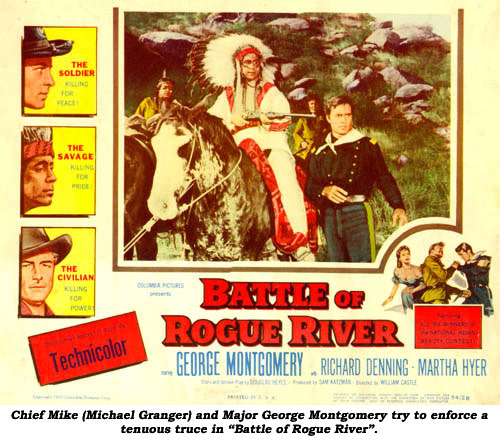
 LONE GUN (‘54 United Artists) Montgomery is appointed Marshal of a town while his pal, Frank Faylen, is the new gambler come to town. (Yes, like Wyatt and Doc!) Three brothers, Neville Brand, Bob Wilke and Douglas Kennedy, are using the ranch of young Skip Homeier and his sister, Dorothy Malone, to graze their rustled cattle while leisurely changing brands. When Homeier finally gets brave enough to expose them, the brothers frame Faylen for his murder. Faylen steals the show as the “talented” and verbose card sharp, a delight to watch. Remade as “Gambler Wore a Gun” in ‘61 w/Jim Davis. LONE GUN (‘54 United Artists) Montgomery is appointed Marshal of a town while his pal, Frank Faylen, is the new gambler come to town. (Yes, like Wyatt and Doc!) Three brothers, Neville Brand, Bob Wilke and Douglas Kennedy, are using the ranch of young Skip Homeier and his sister, Dorothy Malone, to graze their rustled cattle while leisurely changing brands. When Homeier finally gets brave enough to expose them, the brothers frame Faylen for his murder. Faylen steals the show as the “talented” and verbose card sharp, a delight to watch. Remade as “Gambler Wore a Gun” in ‘61 w/Jim Davis.
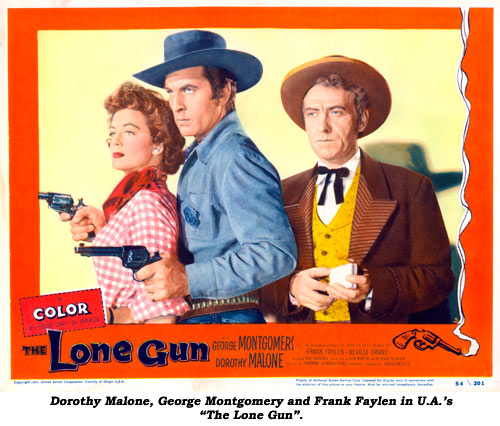
 MASTERSON OF KANSAS (‘54 Columbia) Not an iota of fact in this Technicolor “history les-son,” but it’s exciting fun as Sheriff Bat Masterson (Montgomery) and Doc Holliday (James Griffith) forge an unfriendly alliance to prevent a hanging—and an Indian uprising by Jay Silverheels. Wyatt Earp’s in here too—poorly played with no strength by Bruce Cowling, but it’s Griffith’s show all the way as he brings real life to his staid portrayal of Holliday. Griffith was one of the ‘50s-‘60s best character players; his performances, in good or bad films, are always worthy of watching. MASTERSON OF KANSAS (‘54 Columbia) Not an iota of fact in this Technicolor “history les-son,” but it’s exciting fun as Sheriff Bat Masterson (Montgomery) and Doc Holliday (James Griffith) forge an unfriendly alliance to prevent a hanging—and an Indian uprising by Jay Silverheels. Wyatt Earp’s in here too—poorly played with no strength by Bruce Cowling, but it’s Griffith’s show all the way as he brings real life to his staid portrayal of Holliday. Griffith was one of the ‘50s-‘60s best character players; his performances, in good or bad films, are always worthy of watching.
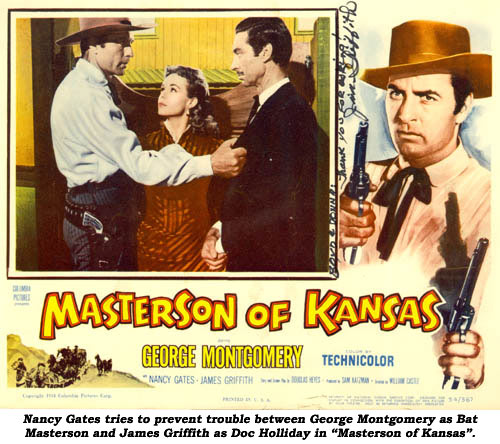
 ROBBER’S ROOST (‘55 United Artists) Inferior Montgomery remake of Zane Grey’s story which was filmed originally by Fox with George O’Brien in ‘33. Although the first telling of the story lacked energy, this muddled version lacks even more punch with wheelchair bound cattleman Bruce Bennett believing “it takes a thief to catch a thief,” thereby hiring two rival rustler bands, one led by Richard Boone and another by (miscast) Peter Graves, to “protect” his vast cattle empire. Enter Montgomery, also perceived to be in league with the rustlers, although we later learn his true motives for joining the rustler band. Contains dreadfully out of place songs by Tony Romano that leave one musing, “Who did he know to get this job?” ROBBER’S ROOST (‘55 United Artists) Inferior Montgomery remake of Zane Grey’s story which was filmed originally by Fox with George O’Brien in ‘33. Although the first telling of the story lacked energy, this muddled version lacks even more punch with wheelchair bound cattleman Bruce Bennett believing “it takes a thief to catch a thief,” thereby hiring two rival rustler bands, one led by Richard Boone and another by (miscast) Peter Graves, to “protect” his vast cattle empire. Enter Montgomery, also perceived to be in league with the rustlers, although we later learn his true motives for joining the rustler band. Contains dreadfully out of place songs by Tony Romano that leave one musing, “Who did he know to get this job?”
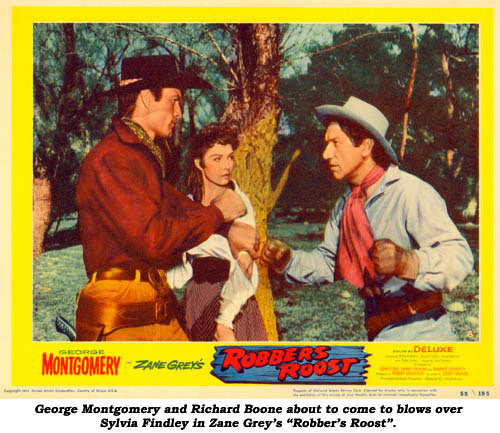
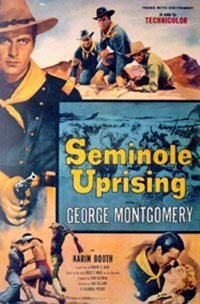  SEMINOLE UPRISING (‘55 Columbia) Lt. Montgomery, the half-white/half-Indian brother of Seminole Chief Black Cat who has fled his Florida reservation, is sent to retrieve Black Cat who has taken a Colonel’s daughter prisoner. Veteran character actor William Fawcett is Montgomery’s rusty scout (and part-time narrator of the film). Suffers from mismatched action stock footage. SEMINOLE UPRISING (‘55 Columbia) Lt. Montgomery, the half-white/half-Indian brother of Seminole Chief Black Cat who has fled his Florida reservation, is sent to retrieve Black Cat who has taken a Colonel’s daughter prisoner. Veteran character actor William Fawcett is Montgomery’s rusty scout (and part-time narrator of the film). Suffers from mismatched action stock footage.
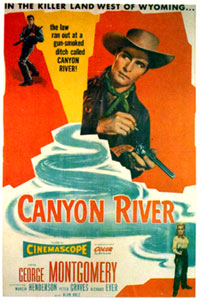  CANYON RIVER (‘56 Allied Artists) Scripter Dan Ullman remade his “Longhorn” (‘51) which starred Bill Elliott. Same exact story—substitute Mont-gomery for Elliott, Peter Graves for Myron Healey and Marcia Henderson for Phyllis Coates. Cinemascope and color help but the lengthier 80 minute running time slows down the pace. CANYON RIVER (‘56 Allied Artists) Scripter Dan Ullman remade his “Longhorn” (‘51) which starred Bill Elliott. Same exact story—substitute Mont-gomery for Elliott, Peter Graves for Myron Healey and Marcia Henderson for Phyllis Coates. Cinemascope and color help but the lengthier 80 minute running time slows down the pace.
ZERO PAWNEE (‘57 Republic) Moronic, clichéd, cheaply-produced and abysmally directed by George WaGGner, “Pawnee” represents the nadir of Montgomery’s westerns. Even being in Trucolor hinders more than helps when mismatched Eastmancolor stock footage battle scenes lifted from “Sitting Bull” are incorporated all throughout the picture. Other than these stock battle-scenes, there’s precious little action, just a lifeless wagon train sludging across sparse soundstage green-sets. The shots of homesteaders supposedly driving covered wagons are the poorest blue-screen shots I’ve ever witnessed. Ludicrous story has Montgomery as a white man adopted and reared by Pawnees. Growing up with confused feelings, he’s betrothed to Indian maid Charlotte Austin. Leaving the Pawnees to discover his white heritage, George becomes a scout for a wagon train of settlers and falls in love with Lola Albright. A really drab, unlikable endeavor.
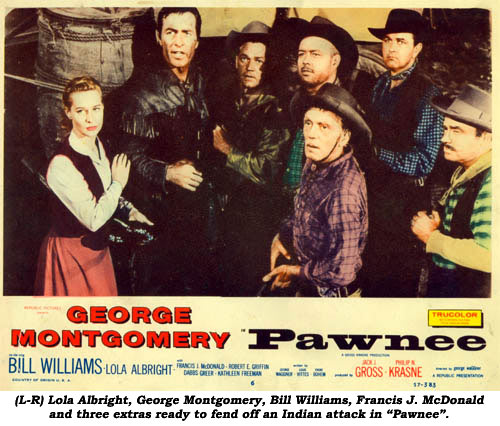
 LAST OF THE BADMEN (‘57 Allied Artists) A gang breaks wanted outlaws out of jail then kills them to collect the reward. Sound familiar? See: “Flaming Bullets”, “Wanted Dead or Alive”, “Star of Texas”, “Gunfight at Comanche Creek”, they’re all the same. Narrated in semi-documentary style, this version with Montgomery is probably the best. LAST OF THE BADMEN (‘57 Allied Artists) A gang breaks wanted outlaws out of jail then kills them to collect the reward. Sound familiar? See: “Flaming Bullets”, “Wanted Dead or Alive”, “Star of Texas”, “Gunfight at Comanche Creek”, they’re all the same. Narrated in semi-documentary style, this version with Montgomery is probably the best.
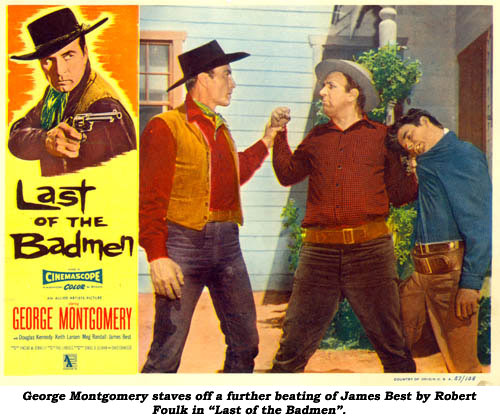
 GUN DUEL IN DURANGO (‘57 United Artists) Montgomery breaks off with the outlaw gang he’s headed up in order to reform and settle down with old girlfriend Ann Robinson. Finding young Bobby Clark (star of TV’s “Casey Jones” with Alan Hale Jr.) orphaned on the trail, he takes the boy under his wing and tries to bury his outlaw past, but his former comrades (Steve Brodie, Don Barry) figure “Either you’re with us or you’re dead.” Roy Barcroft has a small role as a rancher. GUN DUEL IN DURANGO (‘57 United Artists) Montgomery breaks off with the outlaw gang he’s headed up in order to reform and settle down with old girlfriend Ann Robinson. Finding young Bobby Clark (star of TV’s “Casey Jones” with Alan Hale Jr.) orphaned on the trail, he takes the boy under his wing and tries to bury his outlaw past, but his former comrades (Steve Brodie, Don Barry) figure “Either you’re with us or you’re dead.” Roy Barcroft has a small role as a rancher.
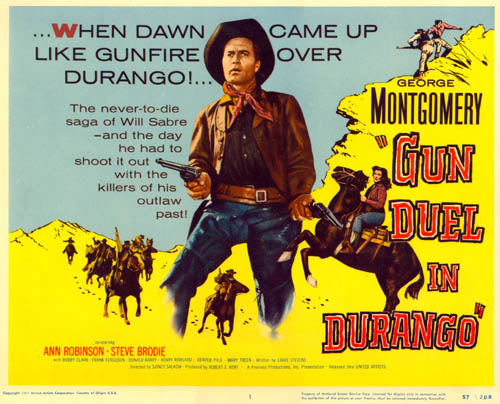
 BLACK PATCH (‘57 Warner Bros.) Written by badman actor Leo Gordon (who wrote a terrific likeable outlaw role for himself), this is Leo’s attempt at western film noir…psychological, starkly and darkly photographed with well defined characterizations and top drawer supporting performances from House Peters Jr., Sebastian Cabot, Strother Martin, Gordon himself and, possibly, star Montgomery’s best acting in a western. George loved the script and produced the film. Watch for Dan Blocker (as a blacksmith) in one of his earliest appearances. BLACK PATCH (‘57 Warner Bros.) Written by badman actor Leo Gordon (who wrote a terrific likeable outlaw role for himself), this is Leo’s attempt at western film noir…psychological, starkly and darkly photographed with well defined characterizations and top drawer supporting performances from House Peters Jr., Sebastian Cabot, Strother Martin, Gordon himself and, possibly, star Montgomery’s best acting in a western. George loved the script and produced the film. Watch for Dan Blocker (as a blacksmith) in one of his earliest appearances.
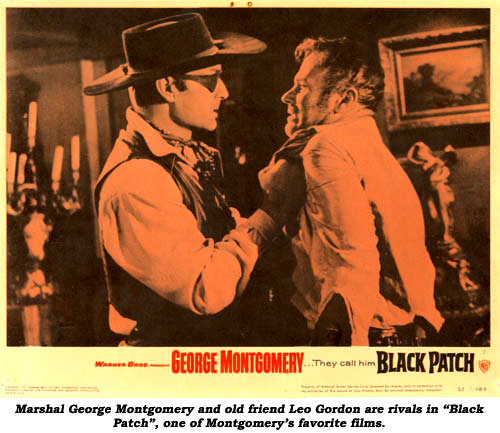
 BADMAN’S COUNTRY (‘58 Peerless/Warner Bros.) From the famous outlaw/lawman cycle of westerns comes the most impossible mythical alliance of lawmen and badmen in western screen history as Butch Cassidy (Neville Brand) leads a Wild Bunch into Abilene, KS, hoping to grab a half million dollar payload. Russell Johnson is the Sundance Kid, Richard Devon is Harvey Logan, Fred Graham is Black Jack Ketchum. Luring the Wild Bunch into the trap are Pat Garrett (George Montgomery), Wyatt Earp (Buster Crabbe), Bat Masterson (Gregory Walcott) and Buffalo Bill (Malcolm Atterbury). BADMAN’S COUNTRY (‘58 Peerless/Warner Bros.) From the famous outlaw/lawman cycle of westerns comes the most impossible mythical alliance of lawmen and badmen in western screen history as Butch Cassidy (Neville Brand) leads a Wild Bunch into Abilene, KS, hoping to grab a half million dollar payload. Russell Johnson is the Sundance Kid, Richard Devon is Harvey Logan, Fred Graham is Black Jack Ketchum. Luring the Wild Bunch into the trap are Pat Garrett (George Montgomery), Wyatt Earp (Buster Crabbe), Bat Masterson (Gregory Walcott) and Buffalo Bill (Malcolm Atterbury).
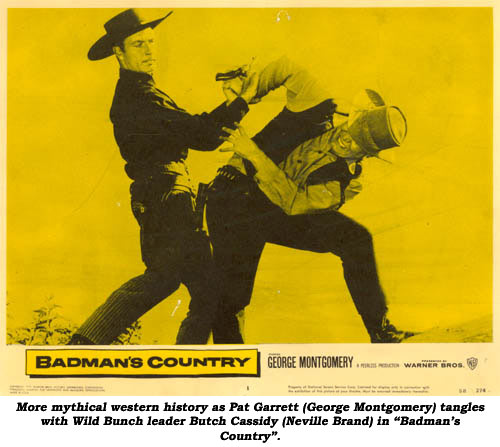
 MAN FROM GOD’S COUNTRY (‘58 Allied Artists) Montgomery trails a herd of cattle to Montana intending to go into ranching with his old Civil War friend, House Peters Jr., but learns Peters is in the grip of town boss Frank Wilcox who intends to keep the railroad out in order to control the town’s freighting business. MAN FROM GOD’S COUNTRY (‘58 Allied Artists) Montgomery trails a herd of cattle to Montana intending to go into ranching with his old Civil War friend, House Peters Jr., but learns Peters is in the grip of town boss Frank Wilcox who intends to keep the railroad out in order to control the town’s freighting business.
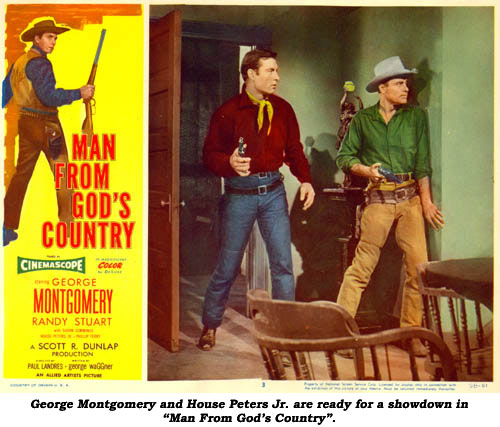
 TOUGHEST GUN IN TOMBSTONE (‘58 United Artists) Ranger Captain Mont-gomery heads for Tombstone to infiltrate a gang of rustlers selling stolen cattle in exchange for Mexican silver, then legalizing it through a U.S. silver mine. The outlaws are led by Jim Davis (Johnny Ringo), Gerald Milton (Ike Clanton) and Lane Bradford (Curly Bill Brocious). Unfortunately, George’s young son Scotty Morrow was witness to his mother’s murder by the same gang and is now hunted by the killers. When George supposedly becomes an outlaw to infiltrate the gang, it puts a severe strain on his relationship with his son. After 10 years as a top western star, Montgomery now moved to the “new thing”—television, where he held forth as Mayor Matt Rockford on “Cimarron City” for the ‘58-‘59 season. TOUGHEST GUN IN TOMBSTONE (‘58 United Artists) Ranger Captain Mont-gomery heads for Tombstone to infiltrate a gang of rustlers selling stolen cattle in exchange for Mexican silver, then legalizing it through a U.S. silver mine. The outlaws are led by Jim Davis (Johnny Ringo), Gerald Milton (Ike Clanton) and Lane Bradford (Curly Bill Brocious). Unfortunately, George’s young son Scotty Morrow was witness to his mother’s murder by the same gang and is now hunted by the killers. When George supposedly becomes an outlaw to infiltrate the gang, it puts a severe strain on his relationship with his son. After 10 years as a top western star, Montgomery now moved to the “new thing”—television, where he held forth as Mayor Matt Rockford on “Cimarron City” for the ‘58-‘59 season.
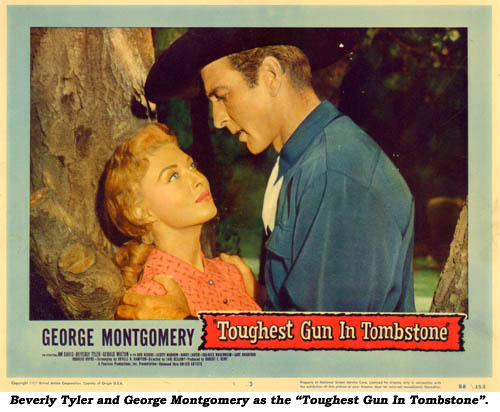
 KING OF THE WILD STALLIONS (‘59 Allied Artists) Diane Brewster and her foreman fiancé, Montgomery, need $500 to save her ranch; coincidentally, just the price being offered for the capture of wild stallion Black Lightning by Emile Meyer, who’s the one after Brewster’s ranch. Altogether, a pretty tame “hoss” opera with a nice turn by Edgar Buchanan as George’s pal. KING OF THE WILD STALLIONS (‘59 Allied Artists) Diane Brewster and her foreman fiancé, Montgomery, need $500 to save her ranch; coincidentally, just the price being offered for the capture of wild stallion Black Lightning by Emile Meyer, who’s the one after Brewster’s ranch. Altogether, a pretty tame “hoss” opera with a nice turn by Edgar Buchanan as George’s pal.
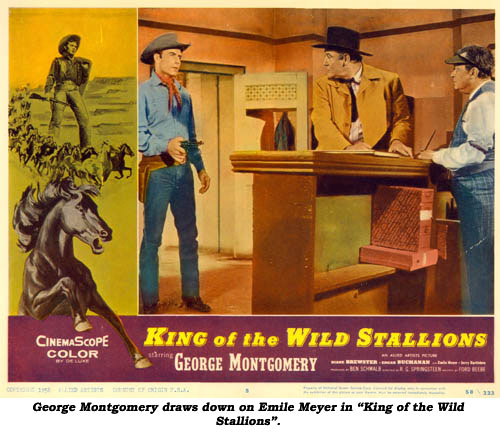
ZERO OUTLAW OF RED RIVER (‘66 Harold Goldman Enterprises) His career slipping, Montgomery made several low budget adventure films in the Philippines between ‘59 and ‘64. By ‘66, with the success of the Eastwood/Leone spaghetti westerns, most American western stars were turning to the Continent for work. Montgomery’s sole contribution to the genre is this slow, dull, talky effort filmed in Spain. Resembling an Hispanic soap opera, Montgomery is a falsely accused Texan hiding out in Mexico and working as foreman on the Rancho of a General who is in love with a devious woman who has a brother trying to bed the General’s snotty daughter. Subplot has George flushing out a bandido murderer causing trouble between the two feuding Rancheros.
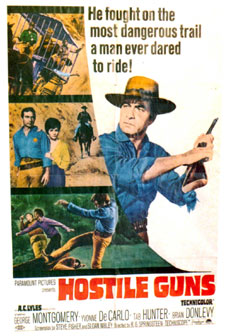  HOSTILE GUNS (‘67 Paramount) Great title and a good premise gone wrong in what should have been one of producer A. C. Lyles’ best westerns, but it turns midway into a talkfest. U.S. Marshal Montgomery is given charge of four criminals (mean Leo Gordon, sentenced to hang; pompous, corrupt railroad executive Robert Emhardt; Pedro Gonzales-Gonzales, a goat thief; and Yvonne De Carlo [never looking worse] who shot her two-timing lover) to escort across the Texas badlands in a prison wagon. Montgomery enlists the aid of hot-headed, naïve, young Tab Hunter as his deputy. During the trek, De Carlo attempts to seduce Hunter into letting her go, nearly succeeding, until Montgomery throws the gullible Hunter in the wagon with the crooks, leaving George all alone to fend off the attacks of Gordon’s kin, John Russell and James Craig. As with all Lyles’ productions, the supporting cast is populated with old pros: saloon owner Don Barry; sheriff Richard Arlen; Marshal Brian Donlevy; ranch hand Fuzzy Knight; Hunter’s tough uncle Emile Meyer; outlaw Read Morgan; and prison wagon carpenter William Fawcett. HOSTILE GUNS (‘67 Paramount) Great title and a good premise gone wrong in what should have been one of producer A. C. Lyles’ best westerns, but it turns midway into a talkfest. U.S. Marshal Montgomery is given charge of four criminals (mean Leo Gordon, sentenced to hang; pompous, corrupt railroad executive Robert Emhardt; Pedro Gonzales-Gonzales, a goat thief; and Yvonne De Carlo [never looking worse] who shot her two-timing lover) to escort across the Texas badlands in a prison wagon. Montgomery enlists the aid of hot-headed, naïve, young Tab Hunter as his deputy. During the trek, De Carlo attempts to seduce Hunter into letting her go, nearly succeeding, until Montgomery throws the gullible Hunter in the wagon with the crooks, leaving George all alone to fend off the attacks of Gordon’s kin, John Russell and James Craig. As with all Lyles’ productions, the supporting cast is populated with old pros: saloon owner Don Barry; sheriff Richard Arlen; Marshal Brian Donlevy; ranch hand Fuzzy Knight; Hunter’s tough uncle Emile Meyer; outlaw Read Morgan; and prison wagon carpenter William Fawcett.
As his big-screen starring days were ending, George starred on TV's "Cimarron City" in ‘58-‘59. (See write-up on the series under "Do You Remember".
top of page |

